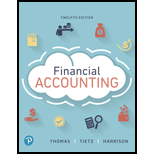
Concept explainers
(Learning Objective 5: Interpret a company’s contingent liabilities) Martinson Cycles, Inc., a motorcycle manufacturer, included the following note in its annual report:
NOTES TO CONSOLIDATED FINANCIAL STATEMENTS
7 (In Part): Commitments and Contingencies
The Company self-insures its product liability losses in the United States up to $3.8 million (catastrophic coverage is maintained for individual claims in excess of $3.8 million up to $26.3 million). Outside the United States, the Company is insured for product liability up to $26.3 million per individual claim and in the aggregate.
1. Why are these contingent (versus real) liabilities?
2. In the United States, how can the
3. How can a contingency outside the United States become a real liability for the company? How does Martinson’s potential liability differ for claims outside the United States?
Want to see the full answer?
Check out a sample textbook solution
Chapter 8 Solutions
Financial Accounting (12th Edition) (What's New in Accounting)
 Survey of Accounting (Accounting I)AccountingISBN:9781305961883Author:Carl WarrenPublisher:Cengage LearningPrinciples of Accounting Volume 1AccountingISBN:9781947172685Author:OpenStaxPublisher:OpenStax College
Survey of Accounting (Accounting I)AccountingISBN:9781305961883Author:Carl WarrenPublisher:Cengage LearningPrinciples of Accounting Volume 1AccountingISBN:9781947172685Author:OpenStaxPublisher:OpenStax College Cornerstones of Financial AccountingAccountingISBN:9781337690881Author:Jay Rich, Jeff JonesPublisher:Cengage Learning
Cornerstones of Financial AccountingAccountingISBN:9781337690881Author:Jay Rich, Jeff JonesPublisher:Cengage Learning





